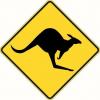I use a low-angle block plane (12 deg bed, 25 deg bevel) until I get very close to flush, then I switch to a finely-set bench plane (usually a #4 or #3 depending on the size of the work).
I sometimes use a skew block because then I can get a skew cut while still "bridging" the sole across multiple dovetails.





 Reply With Quote
Reply With Quote

